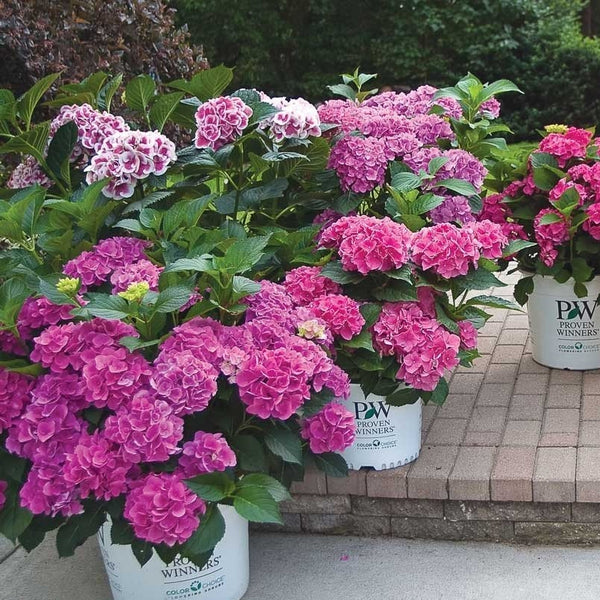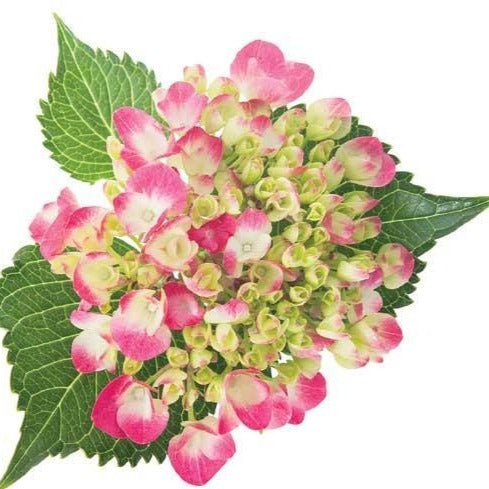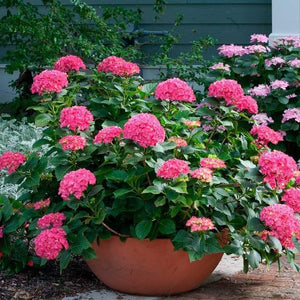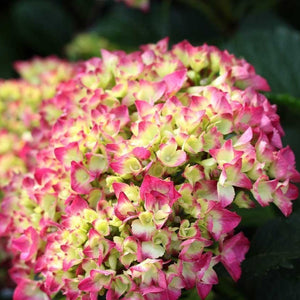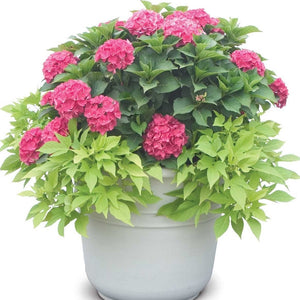Cityline® Paris Bigleaf Hydrangea
Product Details
 Growing Zones 5-9
Growing Zones 5-9
| Soil Type | Acidic, Adaptable, Well Drained |
| Sunlight | Full, Partial |
| Drought Tolerance | Good |
| Mature Height | 1-2 Feet |
| Mature Width | 2-3 Feet |
| Fall Color | Green |
| Bloom Color | Pink |
| Brand | Proven Winners® |
| Shipping Restriction | AZ |
The Cityline® Paris Bigleaf Hydrangea is an improved hybrid from Germany. The Cityline produces bursts of color without sagging branches and has excellent mildew resistance. Its flowers are long lasting and fade to green as they age.
You can plant the Cityline® Paris Hydrangea in groups in a natural area, or in containers with accents and perennials. This petite hydrangea is a dwarf variety that only grows 1 to 3 feet tall and wide.
Cityline Hydrangeas blooms during the summer on old wood. The best time to prune is after blooming but it is not needed which makes this hydrangea low maintenance. Plant in a nice, rich soil and keep watered. The Cityline Hydrangea prefers moist soil with lots of organic material. We highly suggest our special planting mix for each Hydrangea planted. To keep your Hydrangea blooming, use our special high grade, slow release fertilizer.
What Are Good Companion Plants For This Hydrangea?
Hostas, viburnum, and loropetalum all do well paired in a mixed bed or cottage garden with this shrub.
How Should I Prune This Shrub?
These hydrangea dont require pruning but if you decide to prune your hydrangea to encourage new growth, do it after the blooming is done and flowers have faded.
Where Should I Plant A Paris Bigleaf Hydrangea?
Plant this adaptable flowering shrub in a spot that well drained, slightly acidic soil with full sun to part shade exposure in grow zones 5-9.
When planting your Cityline Paris Bigleaf Hydrangea be sure you have the right location and conditions for your new plants to thrive. Spring and Fall are ideal times to plant Hydrangeas. Avoid planting hydrangeas in summer when temperatures are mid80s or higher.
The Cityline Paris Bigleaf Hydrangea requires full sun to part shade and prefers moist, well-drained, fertile soil. In hot climates, hydrangeas will do best with some shade. If you have alkaline soil and want a blue hydrangea, be sure to amend your soil. To acidify your soil, amend with aluminum sulfate or elemental sulfur. If you are seeking a pink color, add lime several times per year. Keep the soil moist, but not saturated, especially in summer and in the first year after planting. Throughout its life Hydrangeas will do best with a deep watering once weekly during hot temperatures. Mulching at about 3 inches deep is highly recommended for hydrangeas. Mulching will cut back on watering needs and protect your plant in extreme temperatures. Choose a slow release fertilizer for flowering plants. Fertilize once in spring after the last chance of frost and again in early summer for best results. You don’t need to prune hydrangeas, but pruning after they are done blooming can help encourage a bushier growth and renew an older plant.
The best way to prevent disease and pests is by providing the appropriate care for your plants. Proper location choice, watering, and fertilization are the keys to your success. You can treat mites, scale, whiteflies, and aphids naturally with neem oil or insecticidal soap. For severe infections you can use pesticides like carbaryl, also known as Sevin. Fungal infection can be prevented by making sure the planting site has good drainage and by avoiding overhead watering. Fungal infections can be treated with a fungicide. Generally, treating fungus after infection isn't effective so if you have problems with other plants or in a prior year, treat preventatively in early spring.
Learn when to prune your flowering shrubs.
For additional options, be sure to browse our Hydrangea, Hydrangea trees and Endless Summer Hydrangea collection.



